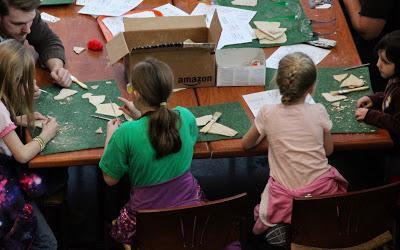
Paleontologists at work.
Thirty-one years ago, a small group of Wyoming citizens launched a campaign to honor a fish, specifically a small uncharismatic herring-like fish that hadn’t been seen for 50 million years. They didn’t get very far. The legislature had no interest in small fish nor the distant past. But these advocates were driven by a passion far exceeding that of most lobbyists—perhaps a passion of innocence, for none were older than twelve.
The next year, they tried again … and this time they succeeded! Knightia was designated State Fossil of Wyoming.
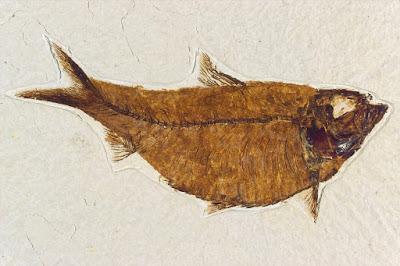
Knightia alta, a bit over 2 inches long; NPS photo.
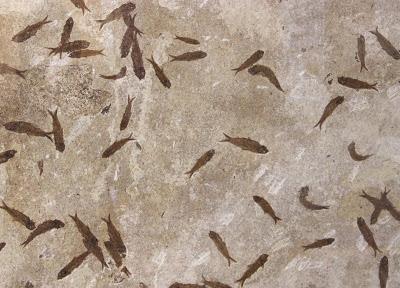
Knightia slab, University of Wyoming Geology Museum.
When these exquisitely-preserved fish fossils began to surface by the thousands, they impressed even the most experienced of experts. Paleontologist Joseph Leidy of the University of Pennsylvania examined fossils sent by geologist Ferdinand Vandeveer Hayden, head of the US Geological Survey of the Territories. In the final report, he wrote:“About two miles west of Rock Springs Station there is an excavation on the railroad which has been called the Petrified Fish Cut, on account of the thousands of beautiful and perfect fossil-fishes which are found on the surface of the thin shales, sometimes a dozen or more on an area of a square foot.” [Leidy 1873; italics added]Leidy identified the fish as Clupea, the genus that includes today’s herring, and described two new fossil species.
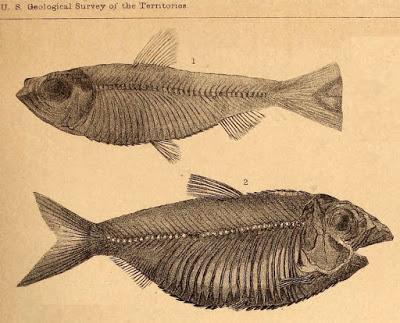
Leidy’s Clupea humilis and C. alta; Figures 1 and 2, Plate XVII, Leidy 1873.
A decade later, one of the biggest names in American paleontology, Edward Drinker Cope, moved the fossils to the genus Dyplomystus. Then in 1907, David Star Jordan split Dyplomystus into two genera, and placed the Wyoming herring fossils in Knightia, where they remain to this day. Jordan named them Knightia to honor Wilbur C. Knight, the first State Geologist of Wyoming, and an “indefatigable student of the paleontology of the Rocky Mountains.” Knight had recently died, in 1903—only 45 years old.
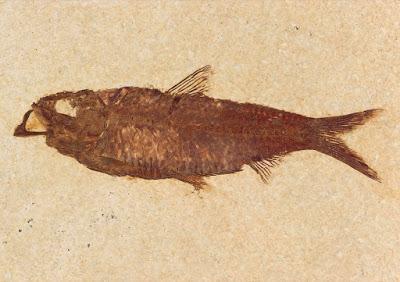
Clupea eocaena Jordan; NPS photo.
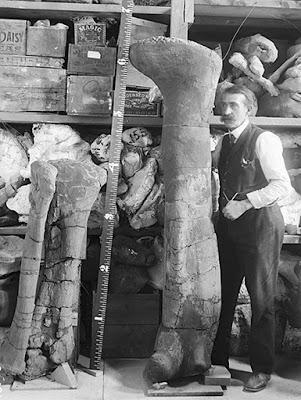
State Geologist and university professor Wilbur C. Knight (photo in UW Geology Museum).
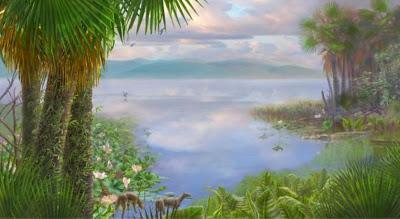
Southwest Wyoming in the Eocene (Chicago Field Museum).
Why so many fish fossils? Because fifty million years ago, great schools of knightias swam in the giant lakes of southwest Wyoming. During periodic die-offs, dead fish accumulated on the lake bottoms where they were entombed in dirt, debris and volcanic ash. Now they're immortalized in lakebed muck turned to shale—the Green River Formation.“In the valley of the latter [Green River] remarkable sections of strata are exposed to view. The group he [Hayden] calls the Green River shales, because the strata are composed of thin layers, varying in thickness from that of a knife-blade to several inches. The rocks all have a grayish-buff color on exposure, sometimes with bands of dark brown. These darker bands are saturated with a bituminous matter which renders them combustible.” (Leidy 1873)
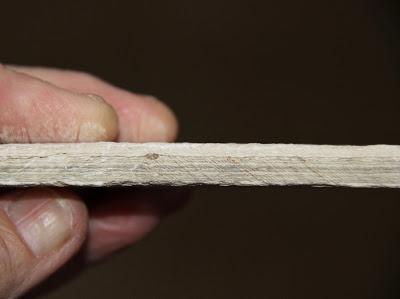
Edge-wise view of Green River shale. Dark hydrocarbon-rich bands give the rock a noticeably oily smell. The little oval structure is fossilized fish poop.
Millions of Knightia fossils have been collected—and continue to be. It’s the most commonly excavated fossil fish in the world! You would think all Wyoming citizens would be proud of a fish with that kind of significance, especially one named for a Founding Father of Wyoming geology. But in 1986 when Mr. Miller's class approached the legislature about designation, they got nowhere.The next year, things looked more promising. A bill was introduced. But an amendment was proposed almost immediately ... to designate the rattlesnake instead. Yikes! Miller and his students were stunned, their hopes sank. Fortunately the amendment was killed. Then another surprise—the bill passed unanimously, with full bipartisan support. Turns out the amendment was a fake, intended as a lesson in the legislative process.

Governor Sullivan signs the Fossil Fish bill under the watchful eyes of Anderson elementary school students.
Last Saturday, we celebrated the thirtieth anniversary of Knightia’s designation—at the Fossil Fish Festival. Experts gave tours of the Geology Museum and collections. Novice paleontologists prepared fossils, carefully scraping away shale bit by bit to reveal tiny bones. Others made fossil rubbings. Faces and arms were painted. We watched Your Inner Fish (very good movie), and even feasted on Knightia! … cookies that is ;-)

Aspiring paleontologists learn the tricks of the trade.
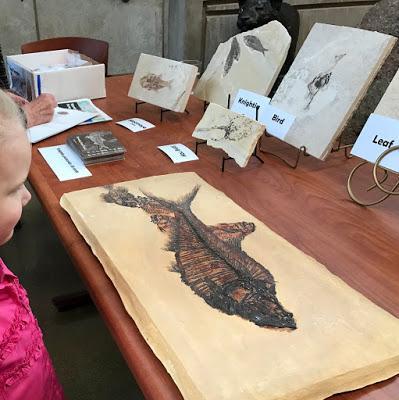
Fossils from the Green River Formation, available for rubbings.

The festival was held in the Berry Center, University of Wyoming, Laramie.
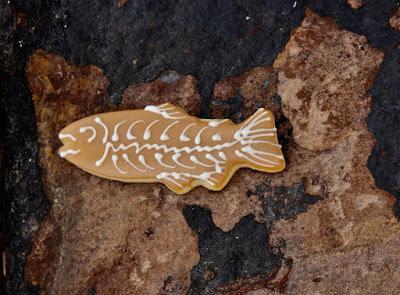 Sources
SourcesGrande, L. 1982. A revision of the fossil genus Knightia… Novitates 2731 (American Museum of Natural History). PDFJordan, DS. 1907. Fossil fishes of California; with supplementary notes on other species of extinct fishes. Bulletin of the Department of Geology, vol. 5. Berkeley :The University Press. [Biodiversity Heritage Library http://www.biodiversitylibrary.org/item/139556]Leidy, J. 1873. Contributions to the extinct vertebrate fauna of the western territories. Washington: Government Printing Office. [Biodiversity Heritage Library http://www.biodiversitylibrary.org/item/125566]
